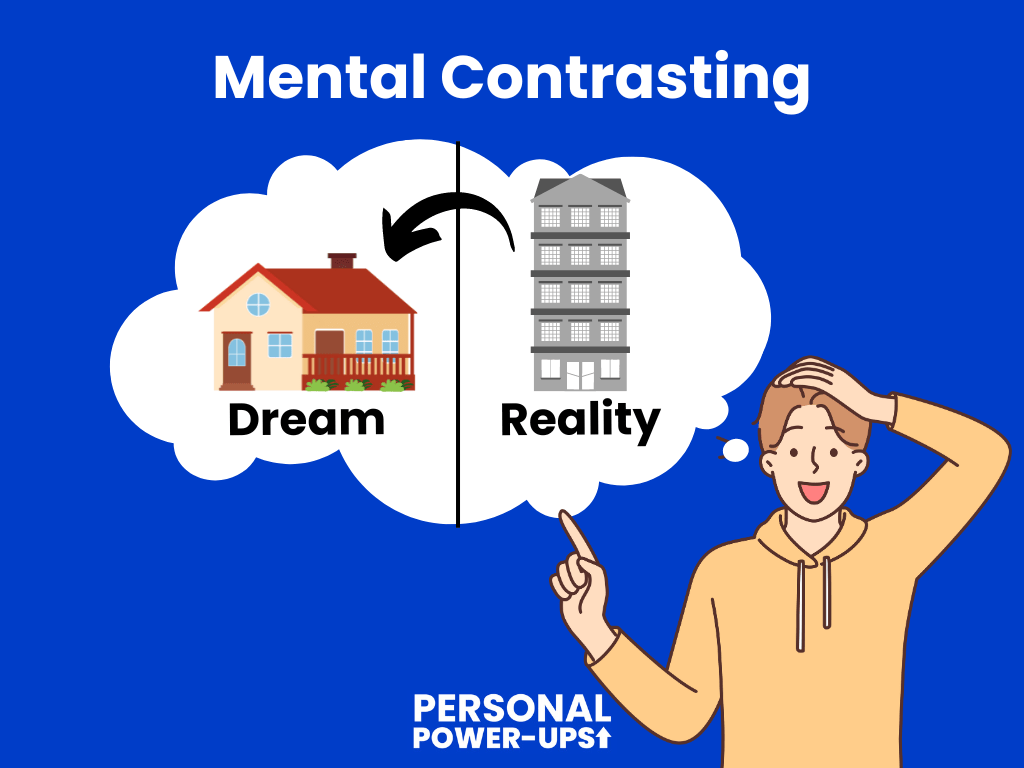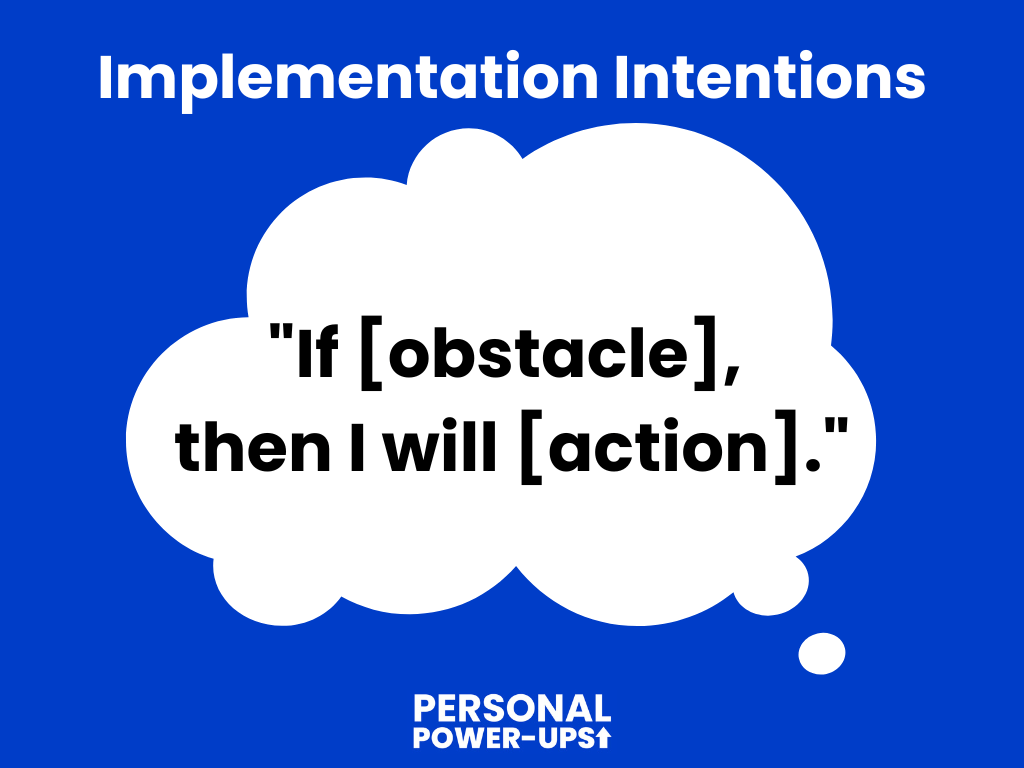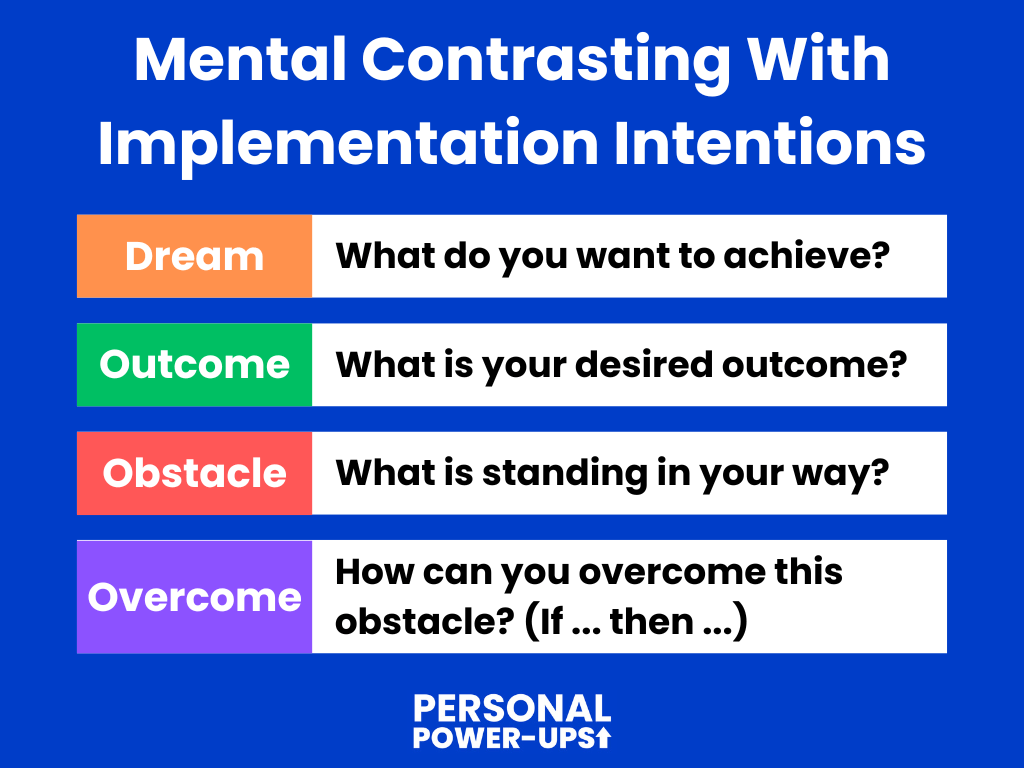Have you ever set a goal with excitement, only to watch it slip away as life gets busy? You’re not alone. Achieving goals is challenging, but there’s a powerful method that helps you bridge the gap between setting goals and actually reaching them: Mental Contrasting with Implementation Intentions (MCII). This technique combines positive thinking and realistic planning to achieve your goals.
Table of Contents
Understanding Mental Contrasting
Mental contrasting is a strategy that involves vividly imagining a desired future while also recognizing the obstacles that could prevent you from achieving it. This approach helps you balance optimism with realism, making your goals more attainable and improving your productivity.
How Mental Contrasting Works
First, you envision your ideal future. Picture the outcome you want in great detail, like a better home or finishing a marathon. Feel the excitement and satisfaction of reaching your goal. Next, shift your focus to the present and identify the barriers that stand between you and this goal. By doing this, you create a mental contrast between where you are and where you want to be.
Example of Mental Contrasting
Imagine you want to run a marathon. You start by visualizing yourself crossing the finish line, feeling elated and accomplished (and also soaked in sweat). You see your friends and family cheering, and you feel proud of your hard work. Then, you think about the challenges: finding time to train, dealing with muscle soreness, and staying motivated during long runs. This contrast between your goal and the reality of the challenges prepares you mentally for what lies ahead.

Understanding Implementation Intentions
Implementation intentions are “if-then” plans that connect your expected obstacles with specific actions to overcome them. By creating detailed plans, you transform abstract goals into concrete steps.
How Implementation Intentions Work
You start by identifying potential obstacles that might derail your progress. Then, you create a specific plan for how you’ll handle each obstacle. The structure of an implementation intention is simple: “If [obstacle], then I will [action].”
Example of Implementation Intentions
Continuing with the marathon example, let’s say one obstacle is finding time to train. Your implementation intention could be: “If I have a busy day at work and can’t run in the evening, then I will wake up an hour earlier the next morning to fit in my training.” By planning your response to obstacles in advance, you make it easier to stick to your goals.

Combining Mental Contrasting with Implementation Intentions (MCII)
MCII integrates mental contrasting and implementation intentions into a cohesive strategy. By first identifying your goals and the obstacles, then planning specific actions to overcome those obstacles, you create a powerful framework for success. MCII has been developed by Prof. Dr. Oettingen.
How MCII Works
- Identify your goal: Clearly define what you want to achieve.
- Visualize the positive outcome: Picture yourself achieving your goal in detail.
- Identify obstacles: Think about what could get in the way of achieving your goal.
- Create if-then plans: Develop specific plans to handle each obstacle.
Example of MCII in Action
Let’s say your goal is to improve your public speaking skills.
- Identify your goal: You want to confidently deliver a presentation at work.
- Visualize the positive outcome: Imagine yourself speaking clearly and engaging your audience. Picture their positive reactions and your sense of accomplishment.
- Identify obstacles: You might get nervous, forget your points, or struggle with time management.
- Create if-then plans:
- If I start to feel nervous, then I will take three deep breaths to calm down.
- If I forget my points, then I will glance at my notes to stay on track.
- If I run out of time, then I will prioritize the most important points to cover.

Benefits of MCII for Personal Growth
Mental Contrasting with Implementation Intentions is not just a tool for achieving specific goals; it’s a powerful strategy for overall personal growth. Here are some ways MCII can help you:
1. Increases Motivation
By vividly imagining your goals and acknowledging the obstacles, you reinforce your commitment. This dual focus keeps you motivated, as you’re constantly reminded of both the reward and the challenges.
Example
If you aim to adopt a healthier diet, visualize yourself enjoying nutritious meals and feeling more energetic. Recognize that cravings for junk food might tempt you. Plan: “If I crave junk food, then I will eat a piece of fruit instead.”
2. Enhances Self-Discipline
MCII strengthens your self-discipline by encouraging you to anticipate challenges and plan your responses. This proactive approach reduces the likelihood of giving in to temptations or distractions.
Example
For a goal of studying for an hour every day, visualize the satisfaction of completing your study session. Recognize the obstacle of getting distracted by your phone. Plan: “If I feel the urge to check my phone, then I will turn it off and put it in another room until I finish studying.”
3. Builds Resilience
Facing and planning for obstacles prepares you to handle setbacks. Instead of being discouraged by challenges, you become resilient and ready to tackle them.
Example
Imagine you want to save money for a vacation. Picture yourself enjoying the trip. Recognize that unexpected expenses might arise. Plan: “If I encounter an unexpected expense, then I will cut back on non-essential spending for the month.”
4. Improves Focus
Mental Contrasting with Implementation Intentions also helps you maintain focus by keeping your goals and action plans at the forefront of your mind. This focused approach minimizes distractions and keeps you on track.
Example
If your goal is to write a book, visualize holding your finished manuscript. Identify the obstacle of procrastination. Plan: “If I feel like procrastinating, then I will set a timer for 15 minutes and write without interruption.”
Practical Tips for Using MCII
To make the most of Mental Contrasting with Implementation Intentions, consider these practical tips:
Be Specific: When creating implementation intentions, be as specific as possible. Vague plans are less effective. For example, instead of saying, “I will exercise more,” say, “I will go for a 30-minute run every Monday, Wednesday, and Friday at 6 AM.”
Visualize Vividly: The more detailed your visualization, the more powerful your mental contrasting will be. Engage all your senses to create a vivid mental image of your goal.
Start Small: If your goal feels overwhelming, break it down into smaller, manageable steps. This makes it easier to create specific implementation intentions and maintain motivation.
Monitor Your Progress: Regularly review your goals and implementation intentions. Adjust them as needed based on your progress and any new obstacles that arise.
Stay Flexible: Life is unpredictable, and obstacles can change. Be ready to adapt your plans and intentions as necessary. Flexibility ensures that you stay on track, even when circumstances shift.




